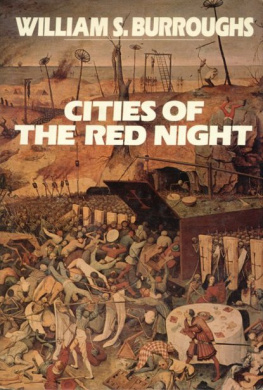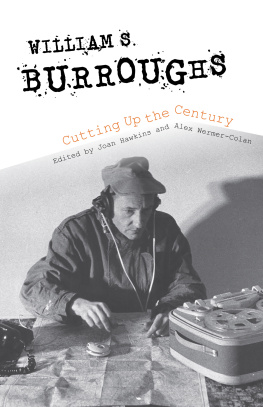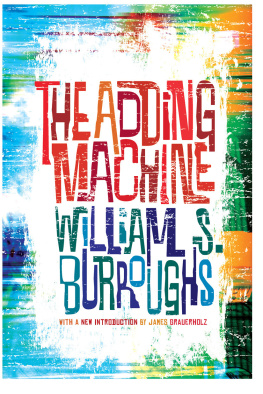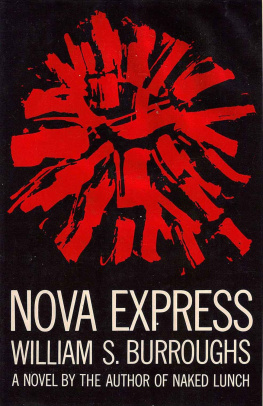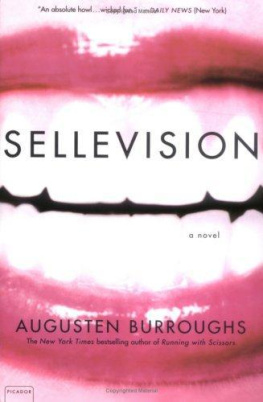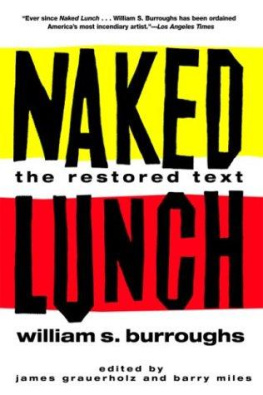William S Burroughs - Cities of the Red Night (Picador)
Here you can read online William S Burroughs - Cities of the Red Night (Picador) full text of the book (entire story) in english for free. Download pdf and epub, get meaning, cover and reviews about this ebook. year: 1982, publisher: Picador, genre: Detective and thriller. Description of the work, (preface) as well as reviews are available. Best literature library LitArk.com created for fans of good reading and offers a wide selection of genres:
Romance novel
Science fiction
Adventure
Detective
Science
History
Home and family
Prose
Art
Politics
Computer
Non-fiction
Religion
Business
Children
Humor
Choose a favorite category and find really read worthwhile books. Enjoy immersion in the world of imagination, feel the emotions of the characters or learn something new for yourself, make an fascinating discovery.
- Book:Cities of the Red Night (Picador)
- Author:
- Publisher:Picador
- Genre:
- Year:1982
- Rating:3 / 5
- Favourites:Add to favourites
- Your mark:
- 60
- 1
- 2
- 3
- 4
- 5
Cities of the Red Night (Picador): summary, description and annotation
We offer to read an annotation, description, summary or preface (depends on what the author of the book "Cities of the Red Night (Picador)" wrote himself). If you haven't found the necessary information about the book — write in the comments, we will try to find it.
Cities of the Red Night (Picador) — read online for free the complete book (whole text) full work
Below is the text of the book, divided by pages. System saving the place of the last page read, allows you to conveniently read the book "Cities of the Red Night (Picador)" online for free, without having to search again every time where you left off. Put a bookmark, and you can go to the page where you finished reading at any time.
Font size:
Interval:
Bookmark:
William Burroughs
CITIES OF THE RED NIGHT
William S. Burroughs, the world-renowned author of Naked Lunch, Junky, Queer,Cities of the Red Night, The Place of Dead Roads, The Western Lands, Interzone, TheCat Inside, My Education: A Book of Dreams and The Letters of William S.
Burroughs 1945-1959, is a member of the American Academy and Institute for Arts and Letters, and a Commandeur de l'Orde des Arts et des Lettres of France. He lives in Lawrence, Kansas.
First published in Great Britain 1981 by John Calder (Publishers) Ltd.
to Brion Gysin
who painted this book before it was written
to James Grauerholz
who edited this book into present time
to Steven Lowe
for his valuable work on the manuscript
to Dick Seaver
my publisher
to Peter Matson
my agent
to all the characters and their real-life counterparts living and dead Contents
Fore! 9
Invocation 13
Book One
The health officer 17
We see Tibet with the binoculars of the people 25
The doctor is on the market 29
Politics here is death 32
The rescue 38
Harbor Point 40
The private asshole 44
Fever spoor 57
The stranger 60
Shore leave 66
Lettre de marque 70
Are you in salt 75
Horse hattock to ride to ride 80
Port Roger 90
Mother is the best bet 99
Quin es? 108
Even the cockroaches 113
Firecrackers 117
Necesita automvil 126
Por convencin Zapata 133
Book Two
Cities of the Red Night 141
Get out of the defensive position 146
We are the language 151
A cowboy in the seven-days-a-week fight 158
The unconscious imitated by a cheesecake 161
We are coordinated The guard is manifold 165
Big Picture calling Shifty 173
Screen play/part one 177
Cheers here are the nondead 184
The sky is thin as paper here 192
tranger qui passait 194
Draft riots 198
Tamaghis revisited 203
Where naked troubadours shoot snotty baboons 208
Book Three
Locker room 213
It is difficult in train "A" 220
I can take the hut set anywhere 223
Please to use studio postulated to you 232
A lecture is being given 237
Afterbirth of dream 247
A walk to the end of the world 251
Moves and checks and slays 256
Will Hollywood never learn 261
Argue second time around such a deal 265
Minutes to go 274
We are here because of you 275
Return to Port Roger 286
Fore!
The liberal principles embodied in the French and American revolutions and later in the liberal revolutions of 1848 had already been codified and put into practice by pirate communes a hundred years earlier. Here is a quote from Under the Black Flag by Don C. Seitz:
Captain Mission was one of the forbears of the French Revolution. He was one hundred years in advance of his time, for his career was based upon an initial desire to better adjust the affairs of mankind, which ended as is quite usual in the more liberal adjustment of his own fortunes. It is related how Captain Mission, having led his ship to victory against an English man-of-war, called a meeting of the crew. Those who wished to follow him he would welcome and treat as brothers; those who did not would be safely put ashore. One and all embraced the New Freedom. Some were for hoisting the Black Flag at once but Mission demurred, saying that they were not pirates but liberty lovers, fighting for equal rights against all nations subject to the tyranny of government, and bespoke a white flag as the more fitting emblem. The ship's money was put in a chest to be used as common property. Clothes were now distributed to all in need and the republic of the sea was in full operation.
Mission bespoke them to live in strict harmony among themselves; that a misplaced society would adjudge them still as pirates. Self-preservation, therefore, and a cruel disposition, compelled them to declare war on all nations who should close their ports to them. "I declare such war and at the same time recommend to you a humane and generous behavior towards your prisoners, which will appear by so much more the effects of a noble soul and as we are satisfied we should not meet the same treatment should our ill fortune or want of courage give us up to their mercy...."
The Nieustadt of Amsterdam was made prize;, giving up two thousand pounds and gold dust and seventeen slaves. The slaves were added to the crew and clothed in the Dutchman's spare garments; Mission made an address denouncing slavery, holding that men who sold others like beasts proved their religion to be no more than a grimace as no man had power of liberty over another....
Mission explored the Madagascar coast and found a bay ten leagues north of Digo-Saurez. It was resolved to establish here the shore quarters of the Republicerect a town, build docks, and have a place they might call their own. The colony was called Libertatia and was placed under Articles drawn up by Captain Mission. The Articles state, among other things: all decisions with regard to the colony to be submitted to vote by the colonists; the abolition of the death penalty; and freedom to follow any religious beliefs or practices without sanction or molestation.
Captain Mission's colony, which numbered about three hundred, was wiped out by a surprise attack from the natives, and Captain Mission was killed shortly afterwards in a sea battle. There were other such colonies in the West Indies and in Central and South America, but they were not able to maintain themselves since they were not sufficiently populous to withstand attack. Had they been able to do so, the history of the world could have been altered. Imagine a number of such fortified positions all through South America and the West Indies, stretching from Africa to Madagascar and the East Indies, all offering refuge to fugitives from slavery and oppression: "Come to us and live under the Articles."
At once we have allies in all those who are enslaved and oppressed throughout the world, from the cotton plantations of the American South to the sugar plantations of the West Indies, and the whole Indian population of the American continent peonized and degraded by the Spanish into subhuman poverty and ignorance, exterminated by the Americans, infected with their vices and diseases, the natives of Africa and Asiaall these are potential allies. Fortified positions supported by and supporting guerilla hit-and-run bands; supplied with soldiers, weapons, medicines and information by the local populations ... such a combination would be unbeatable. If the whole American army couldn't beat the Viet Cong at a time when fortified positions were rendered obsolete by artillery and air strikes, certainly the armies of Europe, operating in unfamiliar territory and susceptible to all the disabling diseases of tropical countries, could not have beaten guerilla tactics plus fortified positions.
Consider the difficulties which such an invading army would face: continual harassment from the guerillas, a totally hostile population always ready with poison, misdirection, snakes and spiders in the general's bed, armadillos carrying the deadly earth-eating disease rooting under the barracks and adopted as mascots by the regiment as dysentery and malaria take their toll. The sieges could not but present a series of military disasters. There is no stopping the Articulated. The white man is retroactively relieved of his burden. Whites will be welcomed as workers, settlers, teachers, and technicians, but not as colonists or masters. No man may violate the Articles.
Imagine such a movement on a world-wide scale. Faced by the actual practice of freedom, the French and American revolutions would be forced to stand by their words. The disastrous results of uncontrolled industrialization would also be curtailed, since factory workers and slum dwellers from the cities would seek refuge in Articulated areas. Any man would have the right to settle in any area of his choosing.
Next pageFont size:
Interval:
Bookmark:
Similar books «Cities of the Red Night (Picador)»
Look at similar books to Cities of the Red Night (Picador). We have selected literature similar in name and meaning in the hope of providing readers with more options to find new, interesting, not yet read works.
Discussion, reviews of the book Cities of the Red Night (Picador) and just readers' own opinions. Leave your comments, write what you think about the work, its meaning or the main characters. Specify what exactly you liked and what you didn't like, and why you think so.

